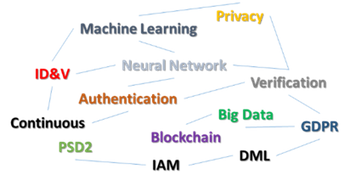 If you’re an Identity and Authentication futurist-junkie, like myself, you’ve probably been bombarded by a slew of tweets, blogs, webinars and old-fashioned e-mail (spam) espousing opinions and innovations in the world of Identity Management.
If you’re an Identity and Authentication futurist-junkie, like myself, you’ve probably been bombarded by a slew of tweets, blogs, webinars and old-fashioned e-mail (spam) espousing opinions and innovations in the world of Identity Management.
It seems every flavor has its own nomenclature and, of course, acronyms – such as IDM, ID&V and IAM – the latter notably covers both access management and data governance. Every day brings an education on emerging trends in consumer privacy (GDPR, PSD2, PPI, PoPI) as well as a parade of summits and events focused on federation and customer identity.
So, What’s All the Fuss About?
Simply put, existing Identity and Access Management (IAM) methods and technologies are not keeping up with the ever-heightening customer expectations for friction-free, mobile and omni-channel communications and commerce. As remote transactions soar and security risks from fraudsters, hackers and other malicious elements escalate, sophisticated workarounds – including the addition of artificial intelligence (AI) and machine learning to the security fabric – have become capable and necessary defense mechanisms.
The bottom line is that doing nothing is not an option. Faster fulfillment is being driven by the ability to digitize more complex transactions. While delighting customers, the trend is compounded by an exposure to financial, reputational and even physical harm, as in the case of online person-to-person (P2P) transacting. The lack of secure, usable and scalable IAM solutions is limiting the adoption of a range of financial, retail, e-government and other services.
At the same time, a growing movement of large-scale, government-driven digital identity activity – such as TUPAS (Finland), Consensys (USA), GOV.UK Verify (UK), SecureKey (Canada), UIDAI (India), X Road (Estonia)– creates new challenges in fraud prevention and risk mitigation. The solutions are very high profile but mostly incremental.
Applying Machine Learning and AI to Fill the Gaps
The application of machine leaning (ML), and it’s higher-grade partner Deep Machine Learning (DML), artificial intelligence (AI), neural networks and other cognitive techniques, applied to ‘big-data’ is yielding all sorts of insights and capabilities from the protective to the predictive. Add Blockchain to this, and it appears that the core building blocks for a perfect IAM solution is at our doorstep.
The plethora of activity has blurred the lines between Authentication and Identification. We predict that there will come a time when IAM ‘transactions’ from distributed contributors (financial services, e-government, social networks, etc.) are secured by privacy-supporting legislation (GDPR, PSD2) and technologies (Blockchain) ultimately providing the confidence for federated digital identity.
Phew! Those are a lot of dots to connect, and while we may well be on the path to such ambitious goals, we are not quite there yet. So for now, we are tasked to ensure that the individual building blocks are fully functional, balancing security with usability, and grow these in incremental steps while contributing to the strategic goal of Continuous Identification and Authentication of individuals as they carry out commerce online, through mobile devices and here in the Real World.
Categories: Conversational Intelligence, Intelligent Authentication, Articles

 Voice AI Agents Redefine CX: Trends, ROI, and Strategies for 2025
Voice AI Agents Redefine CX: Trends, ROI, and Strategies for 2025  Why Voice AI Is Foundational for Enterprise Innovation (Webinar)
Why Voice AI Is Foundational for Enterprise Innovation (Webinar)  Trust and Safety in AI Voice Agents: Insights from Gridspace’s Approach
Trust and Safety in AI Voice Agents: Insights from Gridspace’s Approach  GenAI Trust and Safety: Mitigating Risks and Enabling Solutions
GenAI Trust and Safety: Mitigating Risks and Enabling Solutions